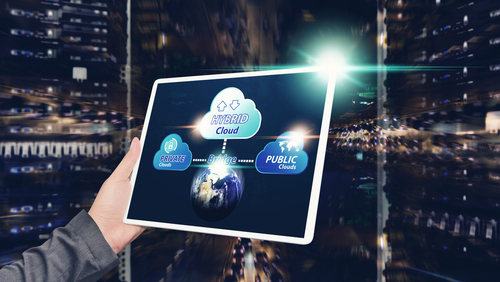Organizations that optimize hybrid cloud or edge computing gain advantages, including faster resolution of issues and downtime, improved performance and enhanced security. The ability to analyze data in near real-time can be particularly advantageous for industries where milliseconds matter.
In this post, we talk with Hervé Tardy, Distributed Power Quality Vice President and General Manager at Eaton, about how edge computing is changing the industry and how to manage these types of environments.
What is hybrid cloud/edge computing and how has it been changing the industry?
A computing environment that relies on a combination of private, on-premises IT infrastructure and one or more public cloud providers, hybrid cloud has emerged as a middle ground for organizations seeking to balance the location of their IT services. It’s also proven to be an ideal partner for edge computing, method of optimizing cloud computing systems by performing analytics, knowledge generation and data processing at the “edge” of the network, which reduces the communications bandwidth required between sensors and the central data center.
Research from Aberdeen has shown that organizations that optimize these technologies gain significant advantages, including faster resolution of issues and downtime, improved performance and enhanced security. By moving computing closer to the edge of the network, companies are able to analyze data in near real-time, which is especially advantageous for industries where milliseconds matter, such as in financial services or manufacturing.
What should IT professionals be mindful of when managing this sort of environment?
To help achieve end-to-end resiliency and reliability in edge computing, IT professionals should heed several considerations. First, it is essential to design the network using the same high quality, certified equipment that would be required by a large enterprise data center. All components must function as an integral unit since any needed repairs can dramatically impact uptime.
In addition, systems should facilitate remote operation and monitoring, with a specialized building automation system to control the environment, detect and report anomalies, and fail-over to on-site redundancy if needed. To further ensure resiliency, servers and storage should also include built-in redundancy and fail-over capabilities, with the ability to operate continuously for long periods of time with little to no intervention.
Ensuring the security of physical edge networking connections and the connectivity of all communication is equally essential. This requires redundant networking components that utilize built-in failover capabilities. Finally, careful selection of the power infrastructure is vital to supporting all elements of edge computing. The ability to maintain power at all times via the use of backup power and integration of the remote monitoring of the power infrastructure into the customer’s management system are paramount. You can do this by seeking UPSs, rackmount power distribution units (PDUs) and power management software with remote capabilities. Being able to remotely reboot UPSs or PDUs can be extremely helpful in edge applications.
In addition, solutions like Eaton’s Intelligent Power Manager software can enhance your disaster avoidance plan by allowing you to set power management alerts, configurations and action policies. By creating action policies for remediation, Eaton enables you to automate server power capping, load shedding and/or virtual machine migration should problems occur.
Where do you see power management going in the future?
With the demand for power hardware steadily dropping — driven in large part by the shift from workloads being housed locally to residing in the cloud — organizations are increasingly relying on software and service solutions. Leading power management manufacturers are responding to this change by bolstering their product lines, introducing new software platforms that feature capabilities aimed at reducing operational expenses, improving system and application reliability, and mitigating risk through data analysis.
Organizations will be best served by easy-to-use, comprehensive power monitoring and management software that integrates into leading platforms and ultimately saves time and simplifies the day-to-day monitoring and management of IT environments. Expect to see more cloud-based software versions, offerings that provide native integration with managed services software, and platforms with intuitive remote monitoring and management capabilities that provide IT professionals with valuable analytics to help make better business decisions. To understand how Eaton’s software integrates with industry IT leaders to save you time and money, visit http://www.eaton.com/us/en-us/products/backup-power-ups-surge-it-power-distribution.html.
Known by CRN as a “channel strategist who doesn’t blink,” Hervé Tardy is a 25-year veteran in the UPS industry and has held multiple positions in sales, channel marketing, product marketing and product development. He manages Eaton’s global product roadmap for single-phase UPSs, software and connectivity products, and has global responsibility for Eaton’s IT Channel marketing program.
Eaton is a power management company with 2017 sales of $20.4 billion. We provide energy-efficient solutions that help our customers effectively manage electrical, hydraulic and mechanical power more efficiently, safely and sustainably. Eaton is dedicated to improving the quality of life and the environment through the use of power management technologies and services. Eaton has approximately 96,000 employees and sells products to customers in more than 175 countries. For more information, visit our website.
